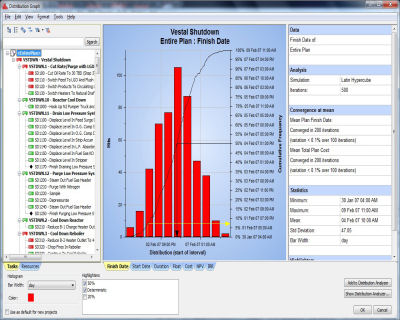ORACLE PRIMAVERA P6 RISK ANALYSIS
Risk Management in the Schedule

WHAT IS ORACLE PRIMAVERA P6 RISK ANALYSIS?
Every project carries risk.
The organizations that succeed are those that proactively plan for these risks—by anticipating, mitigating, and preparing response and contingency plans for negative events that may or may not occur. Oracle Primavera Risk Analysis software provides the tools specifically for this purpose, enabling companies to model risk and analyze its impact on costs and schedules in order to reduce it—thus eliminating much of the uncertainty inherent in project and portfolio management.
By offering easy integration with a wide range of scheduling tools and risk register solutions, Primavera Risk Analysis helps project-driven organizations ensure that critical projects are delivered on time and within budget. It provides full lifecycle cost and schedule risk analysis, as well as straightforward techniques for defining contingency plans, risk responses, and reporting on confidence levels for project success.

ORACLE PRIMAVERA P6 RISK ANALYSIS
The tool helps in the identification, assessment, and management of project-related risks. It allows you to assign different risk levels to various tasks within the project.
It is an advanced statistical analysis technique that enables the project to be simulated multiple times, taking into account different risk scenarios. This allows project managers to gain a deeper understanding of potential project outcomes under various risk conditions.
Thanks to Monte Carlo simulations, Primavera P6 Risk Analysis enables the forecasting of potential project costs and duration, while taking risk factors into account.
It enables the assessment and management of risk at the project portfolio level, which is essential for organizations managing multiple projects simultaneously.
Integration with the core project management software, Primavera P6 EPPM, enables consistent management of projects, resources, and the project portfolio.
Generating reports and analyzing simulation results helps support informed decision-making in project risk management.
SOLUTIONS
Tornado Analysis helps users identify the key risk factors and pinpoint the task or risk event that is preventing the schedule from being executed as planned. Alternatively, users can use cost sensitivity reports to isolate tasks or events that are most critical to overall project costs.
Interactive drill-down capabilities within the tornado charts allow for quick and easy identification of risk drivers, making it easier to report on the most significant risks.
The tornado chart helps visualize both activities and threats that have the greatest impact on project duration and cost, making it a powerful tool for focusing mitigation efforts where they are most needed.
Users can utilize this type of report to determine the combined probability of meeting specific budgets and completion dates, as well as to perform what-if analyses by interactively adjusting cost and schedule thresholds to reveal the resulting likelihood of success.
The scatter plot displays the relationship between two risk analysis outputs: cost and duration.
Each point on the chart represents a single simulation iteration, with one value determined by its position on the vertical axis and the other on the horizontal axis.
This visual tool helps users understand the distribution and correlation between time and cost outcomes under uncertainty.


